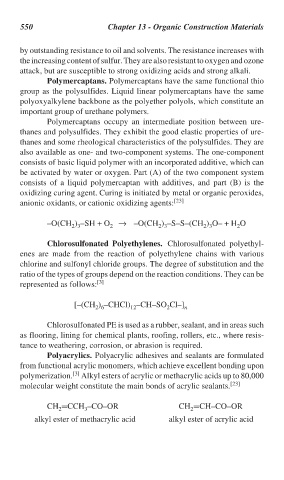Page 580 - Handbook of Thermal Analysis of Construction Materials
P. 580
550 Chapter 13 - Organic Construction Materials
by outstanding resistance to oil and solvents. The resistance increases with
the increasing content of sulfur. They are also resistant to oxygen and ozone
attack, but are susceptible to strong oxidizing acids and strong alkali.
Polymercaptans. Polymercaptans have the same functional thio
group as the polysulfides. Liquid linear polymercaptans have the same
polyoxyalkylene backbone as the polyether polyols, which constitute an
important group of urethane polymers.
Polymercaptans occupy an intermediate position between ure-
thanes and polysulfides. They exhibit the good elastic properties of ure-
thanes and some rheological characteristics of the polysulfides. They are
also available as one- and two-component systems. The one-component
consists of basic liquid polymer with an incorporated additive, which can
be activated by water or oxygen. Part (A) of the two component system
consists of a liquid polymercaptan with additives, and part (B) is the
oxidizing curing agent. Curing is initiated by metal or organic peroxides,
anionic oxidants, or cationic oxidizing agents: [23]
–O(CH ) –SH + O 2 → –O(CH ) –S–S–(CH ) O– + H O
2
2 3
2 3
2 3
Chlorosulfonated Polyethylenes. Chlorosulfonated polyethyl-
enes are made from the reaction of polyethylene chains with various
chlorine and sulfonyl chloride groups. The degree of substitution and the
ratio of the types of groups depend on the reaction conditions. They can be
represented as follows: [3]
[–(CH ) –CHCl) –CH–SO Cl–] n
12
2
2 6
Chlorosulfonated PE is used as a rubber, sealant, and in areas such
as flooring, lining for chemical plants, roofing, rollers, etc., where resis-
tance to weathering, corrosion, or abrasion is required.
Polyacrylics. Polyacrylic adhesives and sealants are formulated
from functional acrylic monomers, which achieve excellent bonding upon
[3]
polymerization. Alkyl esters of acrylic or methacrylic acids up to 80,000
molecular weight constitute the main bonds of acrylic sealants. [23]
CH =CCH –CO–OR CH =CH–CO–OR
2 3 2
alkyl ester of methacrylic acid alkyl ester of acrylic acid

